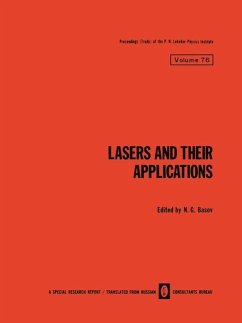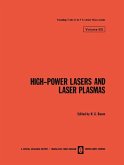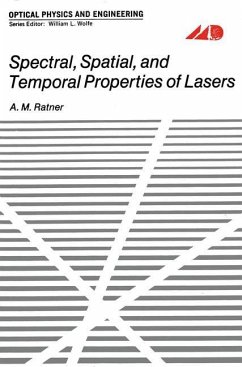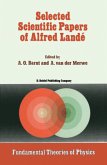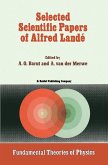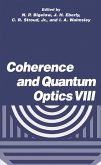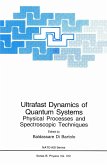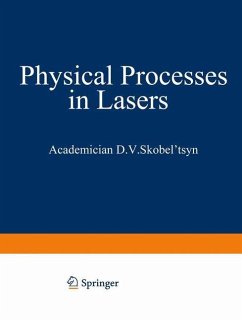Lasers and Their Applications / Lazery I Ikh Primenenie / Лазеры И Их Применение
Herausgegeben:Basov, N. G.
Lasers and Their Applications / Lazery I Ikh Primenenie / Лазеры И Их Применение
Herausgegeben:Basov, N. G.
- Broschiertes Buch
Andere Kunden interessierten sich auch für
![High-Power Lasers and Laser Plasmas / Moshchnye Lazery I Lazernaya Plazma / Мощные Лазеры И Лазерная Плаз& High-Power Lasers and Laser Plasmas / Moshchnye Lazery I Lazernaya Plazma / Мощные Лазеры И Лазерная Плаз&]() High-Power Lasers and Laser Plasmas / Moshchnye Lazery I Lazernaya Plazma / Мощные Лазеры И Лазерная Плаз&63,99 €
High-Power Lasers and Laser Plasmas / Moshchnye Lazery I Lazernaya Plazma / Мощные Лазеры И Лазерная Плаз&63,99 €![Spectral, Spatial, and Temporal Properties of Lasers Spectral, Spatial, and Temporal Properties of Lasers]() A. RatnerSpectral, Spatial, and Temporal Properties of Lasers42,99 €
A. RatnerSpectral, Spatial, and Temporal Properties of Lasers42,99 €![Selected Scientific Papers of Alfred Landé Selected Scientific Papers of Alfred Landé]() P. Barut / A. Van der Merwe (eds.)Selected Scientific Papers of Alfred Landé166,99 €
P. Barut / A. Van der Merwe (eds.)Selected Scientific Papers of Alfred Landé166,99 €![Selected Scientific Papers of Alfred Landé Selected Scientific Papers of Alfred Landé]() Selected Scientific Papers of Alfred Landé166,99 €
Selected Scientific Papers of Alfred Landé166,99 €![Coherence and Quantum Optics VIII Coherence and Quantum Optics VIII]() N.P. Bigelow / J.H. Eberly / C.R. Stroud Jr. / I.A. Walmsley (Hgg.)Coherence and Quantum Optics VIII247,99 €
N.P. Bigelow / J.H. Eberly / C.R. Stroud Jr. / I.A. Walmsley (Hgg.)Coherence and Quantum Optics VIII247,99 €![Ultrafast Dynamics of Quantum Systems Ultrafast Dynamics of Quantum Systems]() Baldassare di Bartolo (ed.)Ultrafast Dynamics of Quantum Systems114,99 €
Baldassare di Bartolo (ed.)Ultrafast Dynamics of Quantum Systems114,99 €![Physical Processes in Lasers Physical Processes in Lasers]() D. V. Skobel tsynPhysical Processes in Lasers42,99 €
D. V. Skobel tsynPhysical Processes in Lasers42,99 €-
-
-
Produktdetails
- The Lebedev Physics Institute Series 76
- Verlag: Springer / Springer US / Springer, Berlin
- Artikelnr. des Verlages: 978-1-4684-1622-0
- 1976 edition
- Seitenzahl: 223
- Erscheinungstermin: 26. Juni 2012
- Englisch
- Abmessung: 279mm x 210mm x 13mm
- Gewicht: 590g
- ISBN-13: 9781468416220
- ISBN-10: 1468416227
- Artikelnr.: 41323573
Hinweis: Dieser Artikel kann nur an eine deutsche Lieferadresse ausgeliefert werden.
- Herstellerkennzeichnung
- Libri GmbH
- Europaallee 1
- 36244 Bad Hersfeld
- gpsr@libri.de
Experimental and Theoretical Investigations of the Dynamics of High-Power Radiation-Emitting Electric Discharges in Gases.- 1. Methods for Initiating Discharges with Large Radiating Surfaces.- 2. Optical, Gasdynamic, and Energy Characteristics of High-Power Electric Discharges.- 3. Self-similar Theory of a Discharge in an Unbounded Medium.- 4. Allowance for the Discharge Circuit Equation in Self-similar Description of a Discharge. Comparison with the Experimental Results.- 5. Numerical Calculations of Characteristics of High-Current Discharges in Air 2.- 6. Stability of High-Current Discharges in Gases.- Literature Cited.- Radiation, Dynamics, and Stability of a High-Current Lithium Discharge Plasma.- I. Theoretical Investigations of High-Current Discharges in Bounded Plasmas.- 1. Steady-State Conditions.- 2. Discharge Stability.- 3. Numerical Calculations of Discharge Dynamics in a Lithium Plasma.- II. Experimental Investigations of Discharges in Lithium Plasmas..- 1. Energy Balance in Discharges.- 2. Dynamics and Stability of Discharges.- 3. Measurements of Radiation Fluxes and Spectra.- 4. Investigations of Large-Scale Structure of Discharges.- 5. Investigations of Small-Scale Structure of Discharges.- 6. Discussion of Results and Comparison with Theory.- Literature Cited.- Generation and Amplification of Light by Stimulated Scattering.- I. Dynamics of Raman Lasers.- 1. Theoretical Analysis of the Dynamics of Emission from a Raman Laser.- 2. Experimental Investigations of Raman Laser Dynamics.- 3. Conditions for Attaining Maximum Quantum Efficiency and Minimum Divergence of Raman Laser Output.- II. Fundamentals of the Theory of Amplifiers Based on Stimulated Scattering.- 1. Equations Describing Amplification.- 2..ParallelAmplification.- 3. Opposed Amplification..- ?. Experimental Investigation of Amplification due to Stimulated Raman Scattering.- 1. Dynamics of Amplification and Saturation Effect.- 2. Influence of Pump Radiation Spectrum on Amplification due to Stimulated Scattering.- 3. Competition between Different Types of Stimulated Scattering.- 4. Formation of Light Pulses with the Aid of Stimulated Scattering.- Literature Cited.- Theoretical Investigation of the Kinetics of Chemical Lasers.- 1. Characteristics of the Kinetics of Pulse Chemical Lasers.- 2. Kinetic Models of H2 + F2 and D2 + F2 + CO2 Systems and Calculation Methods.- 3. H2 + F2 System.- 4. D2 + F2 + CO2 System.- Conclusions.- Literature Cited.- Plasma Heating and Neutron Generation Resulting from Spherical Irradiation of a Target with High-Power Laser Radiation.- I. Desired Parameters of Laser Systems.- 1. Radiation Contrast.- 2. Divergence of Radiation.- 3. Efficiency of Laser Systems.- II. Master Laser and System of Preliminary Amplifying Stages.- 1. General Description of Apparatus.- 2. Master Laser.- 3. Investigation of Spatial-Temporal Coherence of Laser Radiation.- 4, Width of Emission Line.- 5. Amplifying Properties of Preliminary Stages and Parameters of Radiation Leaving These Stages.- III. High-Power Amplifying Stage with Series-Parallel Configuration.- 1. Amplifying Stage Configuration.- 2. System for Dividing High-Power Beams.- 3. Contrast of Radiation Emerging from High-Power Amplifier.- 4. Parameters of Radiation at the Exit from High-Power Amplifier.- 5. System for Focusing Radiation on a Target.- IV. Investigation of the Parameters of a Plasma Formed as a Result of Spherical Irradiation of an Isolated Solid Target.- 1. Vacuum Chamber. DiagnosticApparatus -.- 2. Investigation of the Efficiency of Energy Supply to a Heated Target.- 3. Investigation of X-Ray Emission..- 4. Investigation of the Neutron Yield of Plasma.- 5. Reflection of Laser Radiation from Dense Plasma.- 6. Gasdynamic Pressure of "Corona" and Cumulative Compression of Plasma Core.- Literature Cited.- Investigation of the Parameters and Dynamics of a Plasma Obtained by Sharp Focusing of Laser Radiation on Solid Targets.- 1. Introduction.- 2. Characteristic Parameters of Laser Jets.- 3. Temperature Measurements..- 4. Gasdynamic Motion of Laser Plasmas....- 5. Distribution of Electron Density in Laser Plasmas.- 6. Ionization State of Multiply Charged Laser Plasmas.- 7. Laser Plasma as a Source of Multiply Charged Ions...- Conclusions..- Literature Cited.
Experimental and Theoretical Investigations of the Dynamics of High-Power Radiation-Emitting Electric Discharges in Gases.- 1. Methods for Initiating Discharges with Large Radiating Surfaces.- 2. Optical, Gasdynamic, and Energy Characteristics of High-Power Electric Discharges.- 3. Self-similar Theory of a Discharge in an Unbounded Medium.- 4. Allowance for the Discharge Circuit Equation in Self-similar Description of a Discharge. Comparison with the Experimental Results.- 5. Numerical Calculations of Characteristics of High-Current Discharges in Air 2.- 6. Stability of High-Current Discharges in Gases.- Literature Cited.- Radiation, Dynamics, and Stability of a High-Current Lithium Discharge Plasma.- I. Theoretical Investigations of High-Current Discharges in Bounded Plasmas.- 1. Steady-State Conditions.- 2. Discharge Stability.- 3. Numerical Calculations of Discharge Dynamics in a Lithium Plasma.- II. Experimental Investigations of Discharges in Lithium Plasmas..- 1. Energy Balance in Discharges.- 2. Dynamics and Stability of Discharges.- 3. Measurements of Radiation Fluxes and Spectra.- 4. Investigations of Large-Scale Structure of Discharges.- 5. Investigations of Small-Scale Structure of Discharges.- 6. Discussion of Results and Comparison with Theory.- Literature Cited.- Generation and Amplification of Light by Stimulated Scattering.- I. Dynamics of Raman Lasers.- 1. Theoretical Analysis of the Dynamics of Emission from a Raman Laser.- 2. Experimental Investigations of Raman Laser Dynamics.- 3. Conditions for Attaining Maximum Quantum Efficiency and Minimum Divergence of Raman Laser Output.- II. Fundamentals of the Theory of Amplifiers Based on Stimulated Scattering.- 1. Equations Describing Amplification.- 2..ParallelAmplification.- 3. Opposed Amplification..- ?. Experimental Investigation of Amplification due to Stimulated Raman Scattering.- 1. Dynamics of Amplification and Saturation Effect.- 2. Influence of Pump Radiation Spectrum on Amplification due to Stimulated Scattering.- 3. Competition between Different Types of Stimulated Scattering.- 4. Formation of Light Pulses with the Aid of Stimulated Scattering.- Literature Cited.- Theoretical Investigation of the Kinetics of Chemical Lasers.- 1. Characteristics of the Kinetics of Pulse Chemical Lasers.- 2. Kinetic Models of H2 + F2 and D2 + F2 + CO2 Systems and Calculation Methods.- 3. H2 + F2 System.- 4. D2 + F2 + CO2 System.- Conclusions.- Literature Cited.- Plasma Heating and Neutron Generation Resulting from Spherical Irradiation of a Target with High-Power Laser Radiation.- I. Desired Parameters of Laser Systems.- 1. Radiation Contrast.- 2. Divergence of Radiation.- 3. Efficiency of Laser Systems.- II. Master Laser and System of Preliminary Amplifying Stages.- 1. General Description of Apparatus.- 2. Master Laser.- 3. Investigation of Spatial-Temporal Coherence of Laser Radiation.- 4, Width of Emission Line.- 5. Amplifying Properties of Preliminary Stages and Parameters of Radiation Leaving These Stages.- III. High-Power Amplifying Stage with Series-Parallel Configuration.- 1. Amplifying Stage Configuration.- 2. System for Dividing High-Power Beams.- 3. Contrast of Radiation Emerging from High-Power Amplifier.- 4. Parameters of Radiation at the Exit from High-Power Amplifier.- 5. System for Focusing Radiation on a Target.- IV. Investigation of the Parameters of a Plasma Formed as a Result of Spherical Irradiation of an Isolated Solid Target.- 1. Vacuum Chamber. DiagnosticApparatus -.- 2. Investigation of the Efficiency of Energy Supply to a Heated Target.- 3. Investigation of X-Ray Emission..- 4. Investigation of the Neutron Yield of Plasma.- 5. Reflection of Laser Radiation from Dense Plasma.- 6. Gasdynamic Pressure of "Corona" and Cumulative Compression of Plasma Core.- Literature Cited.- Investigation of the Parameters and Dynamics of a Plasma Obtained by Sharp Focusing of Laser Radiation on Solid Targets.- 1. Introduction.- 2. Characteristic Parameters of Laser Jets.- 3. Temperature Measurements..- 4. Gasdynamic Motion of Laser Plasmas....- 5. Distribution of Electron Density in Laser Plasmas.- 6. Ionization State of Multiply Charged Laser Plasmas.- 7. Laser Plasma as a Source of Multiply Charged Ions...- Conclusions..- Literature Cited.

